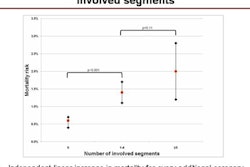Coronary CT angiography (CTA) finds significant coronary artery disease that's missed in treadmill testing -- whether those results are positive, negative, or equivocal, researchers reported at this week's American College of Cardiology (ACC) meeting in New Orleans.
The study from Beaumont Hospital in Royal Oak, MI, examined more than 6,000 patients who underwent several tests to determine which correlated best with coronary CT angiography results in predicting significant (> 50%) stenosis of the coronary arteries. It wasn't stress testing.
"The point of the study was to see if coronary CTA could function as a gatekeeper to the cath lab," said lead investigator Dr. Kavitha Chinnaiyan in an interview with AuntMinnie.com. The group's interest was sparked by a 2010 study by Patel et al of more than 400,000 patients who underwent invasive coronary angiography.
Patel and colleagues found that just 38% of patients undergoing coronary angiography had obstructive coronary artery disease (CAD), indicating, at the least, a poor allocation of resources. In that study, the stress test was a poor predictor of significant stenosis, with an odds ratio (OR) of just 1.23.
The new study conducted by Chinnaiyan, along with Dr. Tauqir Goraya, PhD; Dr. Gilbert Raff; and colleagues from William Beaumont, found that risk factors for heart disease are the strongest predictors of significant CAD on coronary CTA.
The researchers examined the medical records of 6,198 patients without known coronary artery disease at Michigan centers participating in the Advanced Cardiovascular Imaging Consortium (ACIC) registry. All patients had undergone stress tests within the preceding three months.
Patients were divided into three groups depending on whether their stress test was negative, positive, or equivocal, and the researchers analyzed a subset of 621 patients who had catheter angiography after CT "just to see which test would be more predictive at catheter angiography for obstructive coronary artery disease," she said.
A range of data including patient demographics, cardiac risk factors, pretest likelihood by American College of Cardiology/American Heart Association criteria, and results of stress tests were correlated with the severity of coronary artery disease on coronary CTA.
The results showed that it really didn't matter how the stress test came out. Among the 6,198 patients studied, stenosis of 50% or more was seen in 15.3% with normal stress test results, 20.2% with equivocal stress test results, and 19.7% with abnormal stress results.
The following are independent predictors of greater than 50% stenosis in order of importance:
- Male sex (OR: 2.7, 95% confidence interval [CI]: 2.4-3.0)
- Older age (OR: 1.9, 95% CI: 1.8-2.0)
- Hypertension (OR: 1.5, 95% CI: 1.4-1.7)
- Dyslipidemia (OR: 1.4, 95% CI: 1.3-1.5)
- Diabetes (OR: 1.3, 95% CI: 1.17-1.52)
- Abnormal/equivocal stress test results (OR: 1.3, 95% CI: 1.19-1.44)
Clinical risk factors were the strongest predictors of greater than 50% stenosis on coronary CTA (C-statistic, 0.75) compared to pretest likelihood (C-statistic, 0.56) or prior stress test results (C-statistic, 0.53), the group reported.
Among patients undergoing coronary CTA after stress testing, nearly 20% had greater than 50% stenosis on CTA regardless of preceding test results. Clinical risk factors were by far the strongest predictors of significant disease.
Moreover, "we found ... obstructive coronary artery disease in less than 20% of the whole study group," Chinnaiyan said. The other 80% "don't go to the cath lab if CT is performed first," she said.
Among patients undergoing coronary CTA after stress testing, 20% had greater than 50% stenosis on CTA regardless of preceding test results.
"There was not that much of a difference in stress test results between those who had and who did not have obstructive coronary disease," she said. Most people in all categories had normal coronary arteries and didn't need invasive angiography, and stress testing was by far the weakest predictor of obstructive disease.
"Fifty percent of people with normal stress tests had normal coronary arteries; the remaining 50% had disease," Chinnaiyan said. "Now the question is who should be getting the stress test and who should be going to the cath lab -- that's what everybody is trying to answer."
The researchers went on to replicate the findings in a multivariate analysis of the National Cardiovascular Data Registry (NCDR).
"We found that low- to intermediate-risk patients with prior stress tests could benefit from CT to identify who needs to go to a cath lab -- and that stress test results add nothing to it," Chinnaiyan said.



















